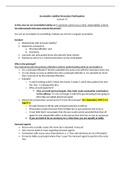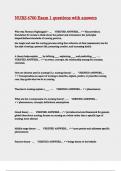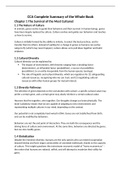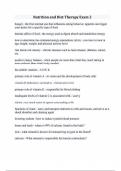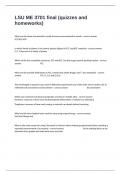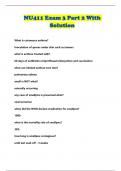ECS3701 EXAM PACK
2024
QUESTIONS AND
ANSWERS
FOR ASSISTANCE CONTACT
EMAIL:
, lOMoARcPSD|46589353
May/June 2020
ECS3701
MONETARY ECONOMICS
Question 1 [20 marks]
1.1 Explain in detail why money is useful and how it facilitates exchange. (6)
1.2 Why did monetary authorities in South Africa decide to adopt inflation targeting? (3)
1.3 List and explain the three costs of inflation. (6)
1.4 Explain the quantity theory of inflation. What will happen to inflation if the growth rate of
money supply exceeds the growth rate of aggregate output? Illustrate with an example. (5)
Question 2 [15 marks]
Given the impact of Covid-19 within the past few months, and the recent downgrading of South
Africa’s sovereign credit rating, the monetary policy committee (MPC) of the South African
Reserve Bank (SARB) decreased the repo rate more than two times. Explain the pros and cons
of this move, including the time lag of monetary policy and considering how should monetary
policy be conducted in recessions. (15)
Question 3 [35 marks]
3.1 List and explain the 2 types of credit that facilitate exchange but do not immediately lead to
an increase in cash or money stock. Elaborate why these credits are not regarded as part of
money. (12)
3.2 Mention and explain the 2 types of monetary policy mandates (10)
3.3 Answer the following question by circling the correct option. Each answer is 1 mark.
Which of the following is correct regarding the effect of a contractionary monetary policy on
price level using the exchange rate transmission mechanism: (13)
, lOMoARcPSD|46589353
Oct/Nov 2020
ECS3701
Monetary Economics
Question 1 [20 marks]
1.1 Mention and explain the 2 types of monetary policy mandates. (10)
1.2 Indicate whether the statement ‘stock affects flows’ is correct or not. Differentiate between
these terms and provide 3 examples of each in the context of economics. (10)
Question 2 [20 marks]
2.1 Explain the quantity theory of inflation and describe the relationship between inflation and
the growth rate of money supply on one hand and the relationship between inflation and the
growth rate of aggregate output on the other hand.
Illustrate the quantity theory of inflation with a mathematical example. (6)
2.2 Circle the correct option from each of the statements below. Using the credit transmission
mechanism, what will the effect of a contractionary monetary policy ultimately be on the price
level?
Question 3 [20 marks]
3.1 Explain the term structure of interest rates. (2)
3.2 List the theories that explain the term structure of interest rates. (3)
3.3 Discuss how collateral and indirect finance are used in explaining the basic facts about
financial structure around the world. (10)
3.4 Explain the role of information in financial markets. What does it lead to? (5)
Question 4 [20 marks]
4.1 State the imperfect definition of money. What does this definition categorize money as? (5)
4.2 Why was the monetary targeting abandoned in South Africa? (5)
4.3 Explain how adverse selection influences the financial structure. (10)
Question 5 [20 marks]
In the wake of the global Covid-19 pandemic, the monetary policy committee (MPC) of the
South African Reserve Bank (SARB) has continuously decreased the repo rate in order to boost
, lOMoARcPSD|46589353
economic activity. You have been asked, as a third year monetary economics student, to advise
the Governor of the South African Reserve Bank on such decision.
In your answer, highlight the following:
(i) mention the type of monetary policy that the SARB embarked on;
(ii) point out the effectiveness of monetary policy,
(iii) state the transmission mechanism that is most effective and why it could be
considered and
(iv) explain 3 costs and 3 benefits of continually decreasing the repo rate.
Downloaded by Gabriel Musyoka ()
2024
QUESTIONS AND
ANSWERS
FOR ASSISTANCE CONTACT
EMAIL:
, lOMoARcPSD|46589353
May/June 2020
ECS3701
MONETARY ECONOMICS
Question 1 [20 marks]
1.1 Explain in detail why money is useful and how it facilitates exchange. (6)
1.2 Why did monetary authorities in South Africa decide to adopt inflation targeting? (3)
1.3 List and explain the three costs of inflation. (6)
1.4 Explain the quantity theory of inflation. What will happen to inflation if the growth rate of
money supply exceeds the growth rate of aggregate output? Illustrate with an example. (5)
Question 2 [15 marks]
Given the impact of Covid-19 within the past few months, and the recent downgrading of South
Africa’s sovereign credit rating, the monetary policy committee (MPC) of the South African
Reserve Bank (SARB) decreased the repo rate more than two times. Explain the pros and cons
of this move, including the time lag of monetary policy and considering how should monetary
policy be conducted in recessions. (15)
Question 3 [35 marks]
3.1 List and explain the 2 types of credit that facilitate exchange but do not immediately lead to
an increase in cash or money stock. Elaborate why these credits are not regarded as part of
money. (12)
3.2 Mention and explain the 2 types of monetary policy mandates (10)
3.3 Answer the following question by circling the correct option. Each answer is 1 mark.
Which of the following is correct regarding the effect of a contractionary monetary policy on
price level using the exchange rate transmission mechanism: (13)
, lOMoARcPSD|46589353
Oct/Nov 2020
ECS3701
Monetary Economics
Question 1 [20 marks]
1.1 Mention and explain the 2 types of monetary policy mandates. (10)
1.2 Indicate whether the statement ‘stock affects flows’ is correct or not. Differentiate between
these terms and provide 3 examples of each in the context of economics. (10)
Question 2 [20 marks]
2.1 Explain the quantity theory of inflation and describe the relationship between inflation and
the growth rate of money supply on one hand and the relationship between inflation and the
growth rate of aggregate output on the other hand.
Illustrate the quantity theory of inflation with a mathematical example. (6)
2.2 Circle the correct option from each of the statements below. Using the credit transmission
mechanism, what will the effect of a contractionary monetary policy ultimately be on the price
level?
Question 3 [20 marks]
3.1 Explain the term structure of interest rates. (2)
3.2 List the theories that explain the term structure of interest rates. (3)
3.3 Discuss how collateral and indirect finance are used in explaining the basic facts about
financial structure around the world. (10)
3.4 Explain the role of information in financial markets. What does it lead to? (5)
Question 4 [20 marks]
4.1 State the imperfect definition of money. What does this definition categorize money as? (5)
4.2 Why was the monetary targeting abandoned in South Africa? (5)
4.3 Explain how adverse selection influences the financial structure. (10)
Question 5 [20 marks]
In the wake of the global Covid-19 pandemic, the monetary policy committee (MPC) of the
South African Reserve Bank (SARB) has continuously decreased the repo rate in order to boost
, lOMoARcPSD|46589353
economic activity. You have been asked, as a third year monetary economics student, to advise
the Governor of the South African Reserve Bank on such decision.
In your answer, highlight the following:
(i) mention the type of monetary policy that the SARB embarked on;
(ii) point out the effectiveness of monetary policy,
(iii) state the transmission mechanism that is most effective and why it could be
considered and
(iv) explain 3 costs and 3 benefits of continually decreasing the repo rate.
Downloaded by Gabriel Musyoka ()

